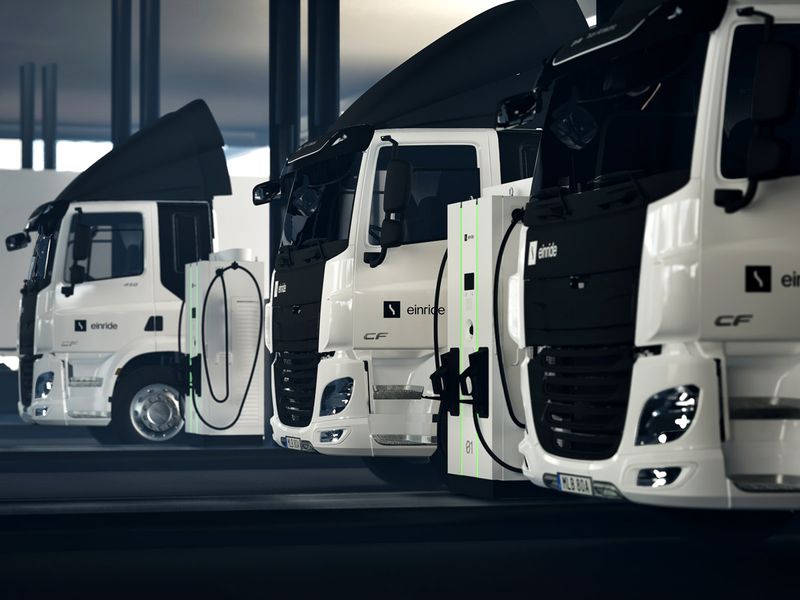How driverless trucks will transform the UAE road freight industry
 The Einride driverless truck. The Swedish company will drive the UAE's ambition to embrace self-driving technology, which is cost effective and environment friendly. Image Credit: Einride
The Einride driverless truck. The Swedish company will drive the UAE's ambition to embrace self-driving technology, which is cost effective and environment friendly. Image Credit: Einride
Driverless trucks are hauling freight through more than a dozen cities in the United States. These autonomous vehicles will become a familiar sight on the UAE highways soon, linking some of the major ports in the country.
Towards the end of the year, electric trucks will be zipping through the roads of Abu Dhabi, Dubai, Sharjah and Al Ain, and in time trucks without drivers will also join the fleet. Electric and autonomous trucking company Einride will drive the UAE's ambition to embrace self-driving technology, which is not only cost effective but also environment friendly. The Swedish company has signed a Memorandum of Understanding (MOU) with the UAE's Ministry of Energy and Infrastructure [MOEI], which will be Einride's first foray outside Europe and the United States.
How Einride autonomous trucks will operate in the UAE
Einride's freight ecosystem works on a grid system called Falcon Rise that covers 550km, stretching across Abu Dhabi, Dubai and Sharjah.
It includes 2,000 electric vehicles (EVs), 200 autonomous vehicles (AVs), eight charging stations and more than 500 charging points. "The establishment of the UAE Falcon Rise grid represents a significant milestone in our journey toward sustainable and intelligent transportation," Sharif Al Olama, MOEI's undersecretary for energy and petroleum affairs, said in a statement. Significantly reduced emissions, improved management of road freight and uninterrupted operations are among the benefits of the freight mobility grid.
With electric cars and e-scooters jostling for space on the streets, trucks can't be far behind. It's more a question of having more charging stations. Einride's freight ecosystem takes care of that.
But the challenge is to keep autonomous trucks on the road. The Falcon Rise grid is the answer. Robert Ziegler, General Manager, EMEA (Europe, Middle East and Africa) at Einride, talked to Gulf News on his company's plans to introduce a green energy fleet to the freight traffic on UAE roads.
 Image Credit: Einride
Image Credit: Einride
When will Einride start operations in the UAE?
Einride has identified the UAE as a key region to deploy its digital, electric and autonomous technologies.
The recently signed MoUs with both the UAE's Ministry of Energy & Infrastructure and Abu Dhabi's Integrated Transport Centre, showcases support from a governmental level which will then help support ongoing conversations with shippers to start operations. Our legal entity is in place, and we are currently in the process of bringing local partners on board. We look forward to deploying initial operations in the latter half of 2024.
How will Einride construct Falcon Rise grid on UAE roads?
We will not build new lanes for the vehicles.
The autonomous vehicles primarily operate on existing roads in areas where our customers currently operate, reducing the likelihood of encountering interference from personal cars and other vehicles. We plan to build out the Falcon Rise Grid, which will deploy the full Einride freight mobility offering including the operating system Einride Saga, electric heavy-duty trucks, autonomous vehicles and charging infrastructure across Abu Dhabi, Dubai, and Sharjah, scaling 550 km. This entails electrifying the current routes used by our shipper clients for their operations and transforming them into digital, electric, and autonomous pathways.
 Einride's freight ecosystem works on a grid system called Falcon Rise that covers 550km, stretching across Abu Dhabi, Dubai and Sharjah. Image Credit: Einride
Einride's freight ecosystem works on a grid system called Falcon Rise that covers 550km, stretching across Abu Dhabi, Dubai and Sharjah. Image Credit: Einride
How long will it take to develop the grid?
The project will be developed over the course of five years.
What's the speed, range and payload capacity of the trucks?
At Einride, we offer two types of vehicles as part of its freight capacity as a service offering -- cabless autonomous trucks that are monitored by remote operators and manned fully electric heavy-duty trucks.
The range and speed of the connected, electric trucks vary given our OEM-agnostic model. On average, they travel around 200km on each charge, with speed and payloads dependent on local regulations of where the vehicles operate. Payload capacity is determined by the truck's configuration, including containers or trailers.
Continuous innovations in the hardware and software we use aim to enhance both speed and payload capacity. The Gen 2 Rigid Large, the latest model of our autonomous vehicle, is capable of speeds in line with local regulations. Due to the repetitive tendencies of flows the vehicle delivers goods on today, speeds are often much lower on a regular basis.
In terms of loading capacity, it has a gross payload of 16 tonnes.
How will Einride trucks impact UAE freight industry?
The UAE has been driving significant changes and innovations and is at the forefront of this transition, aiming to deploy about 4,000 autonomous vehicles by 2030. As one of the first regional countries to enact regulations embracing technological innovation in transportation, we eagerly anticipate collaborating closely with authorities to contribute to this transformative initiative. Einride has the technology to bring great change to the freight industry and look forward to partnering with local entities for the deployment of our autonomous vehicles in conjunction with the Falcon Rise project, confident that we can enhance the momentum in the UAE.
 Einride says, tests for the autonomous vehicle to perform in the Middle East's desert conditions and high temperature have been conducted. Image Credit: Einride
Einride says, tests for the autonomous vehicle to perform in the Middle East's desert conditions and high temperature have been conducted. Image Credit: Einride
Can electric and autonomous trucks operate in desert conditions?
We are working alongside partners, including vehicle OEMs [Original Equipment Manufacturers], charging partners and others, to ensure the full ecosystem best adapts to the weather and temperature conditions the UAE region will bring.
Throughout this year, we've conducted successful tests of a manned CET [Commercial Electric Truck] in the region, in collaboration with one of our OEM partners. Tests for the autonomous vehicle to perform best in the region have also been conducted, further validating the vehicle's capabilities and performance under these specific conditions.
How viable are electric and autonomous trucks for the future of freight?
We anticipate a promising future for these innovations, which are set to transform the freight transport industry and align with our mission of reshaping road freight for a more sustainable tomorrow. Currently, road freight contributes to approximately 8 per cent of global CO2 emissions, even though vehicles are utilised at an average of just around 20 per cent.
In our operational track record spanning four years in the US and EU, we've effectively reduced emissions for our shipper customers by 95 per cent, boosted utilisation rates by 97 per cent, and achieved 99.7 per cent delivery precision. By integrating digital, electric, and autonomous technologies, our goal is to establish an ecosystem that empowers shippers to meet their sustainability goals as well as their business objectives.
Will autonomous trucks replace drivers completely in the near future?
In short, no. With over three million unfilled truck driver jobs and a quarter of the workforce retiring by 2030, there's an urgent need for change to meet rising delivery demands and appeal to younger generations.
While the road freight industry embraces intelligent solutions, opportunities for drivers to operate connected electric trucks will continue. As autonomy grows, a shift to remote operator roles enhances safety and consistency. While the Einride autonomous vehicle is designed to operate autonomously, our remote operators help make autonomous scalable, secure and ensure optimal efficiencies and safety at all times for the community and our vehicles.
At Einride, going autonomous does not mean forgoing the human element. We believe the opposite, that machines are stronger with the human element still in the loop.
 Einride will set up eight charging stations and more than 500 charging points in the Falcon Rise grid in the UAE. On average, the trucks travel around 200km on each charge, says Robert Ziegler, General Manager, EMEA (Europe, Middle East and Africa) at Einride. Image Credit: Einride
Einride will set up eight charging stations and more than 500 charging points in the Falcon Rise grid in the UAE. On average, the trucks travel around 200km on each charge, says Robert Ziegler, General Manager, EMEA (Europe, Middle East and Africa) at Einride. Image Credit: Einride
How's the safety of autonomous trucks?
The Einride autonomous vehicle is the first cabless, purpose-built autonomous vehicle designed for maximum efficiency in goods transportation.
It introduces a new approach to deploying electric, autonomous technology, eliminating the need for a safety driver within the vehicle. Instead, the focus is on the role of the remote operator, who can monitor the vehicle constantly and intervene if necessary. We have implemented multiple systems to ensure the security of the autonomous vehicle and its surroundings, an approach that regulatory bodies have approved in Europe and the US.
Our remote operators can safely manoeuvre the vehicle, interact with officials, and adhere to specific local procedures. Equipped with a state-of-the-art perception system and sensors generating 5 million data points per second, the vehicles use a sensor suite of radars, lidars [Light Detection and Ranging], and cameras for autonomous navigation, including night vision capabilities for around-the-clock operations. Additionally, we believe in and advocate a gradual deployment of autonomous solutions, starting with lower-complexity scenarios and progressing to more complex ones.
The repetitive and predictable nature of freight makes it an ideal environment for scaling and deploying autonomous technologies.
How cost-effective are electric trucks?
Unlocking the potential of electric fleets comes down to harnessing the right mix of digital intelligence for the greatest cost and CO2e savings. At Einride, we achieve cost competitiveness by collaborating with shippers to identify electrification sweet spots in their network, maximising vehicle and charging infrastructure utilisation through digital intelligence. Routes not initially electrified can be addressed in future waves, ensuring cost competitiveness at every step.
In addition, electric trucks can be more cost-effective than diesel trucks in the long run. By 2030, the US Department of Energy predicts almost half of electric trucks in the US will be cheaper to buy, operate, and maintain than diesel trucks. The European Federation for Transport and Environment forecasts that from 2025, electric trucks will outperform diesel trucks in most use cases in terms of total cost of ownership (TCO).
By 2035, all new electric freight trucks in Europe will be cheaper to run, drive just as far, and carry as much cargo as diesel trucks.
More From Special-Reports
 Explainer
Explainer
Flying? Be ready for more weather-driven delays[1]
 Explainer
Explainer
Ramadan: Exercising while fasting? What experts say[2]
 Special Report
Special Report
These residents beat disabilities for fulfilling lives[3]
 Special Report
Special Report
Debunked: You don't need to take 10k steps daily[4]
References
- ^ Flying?
Be ready for more weather-driven delays
(gulfnews.com) - ^ Ramadan: Exercising while fasting?
What experts say
(gulfnews.com) - ^ These residents beat disabilities for fulfilling lives (gulfnews.com)
- ^ Debunked: You don't need to take 10k steps daily (gulfnews.com)